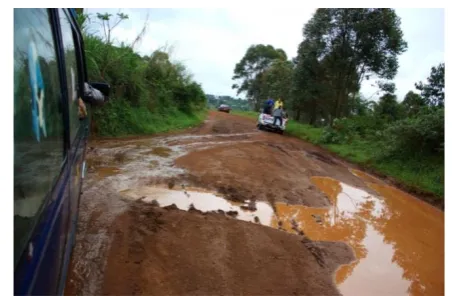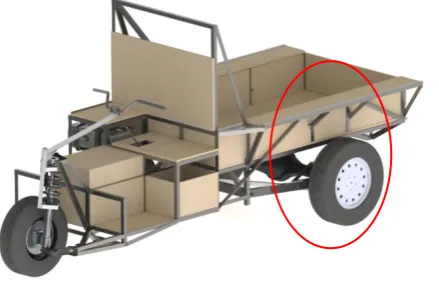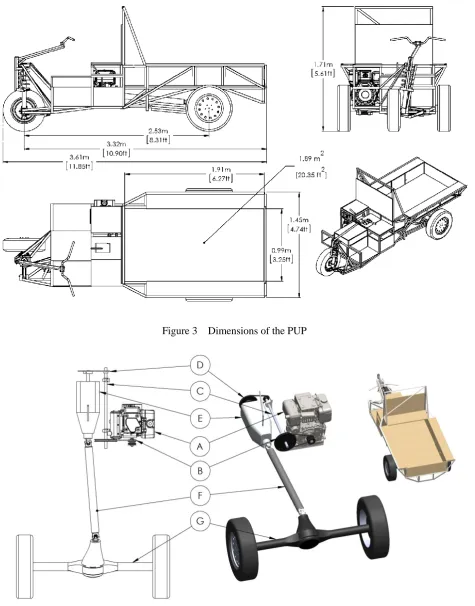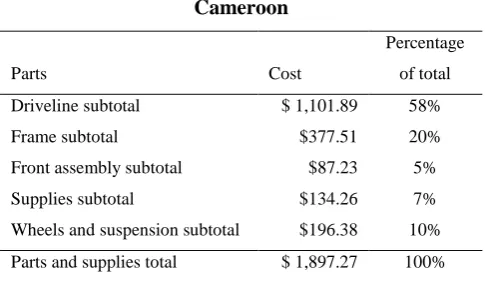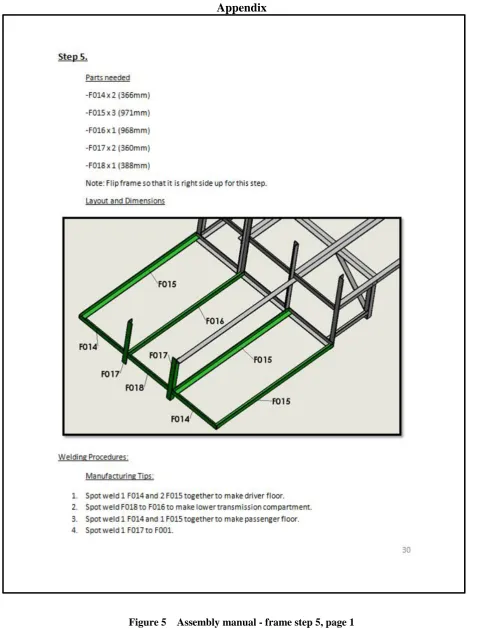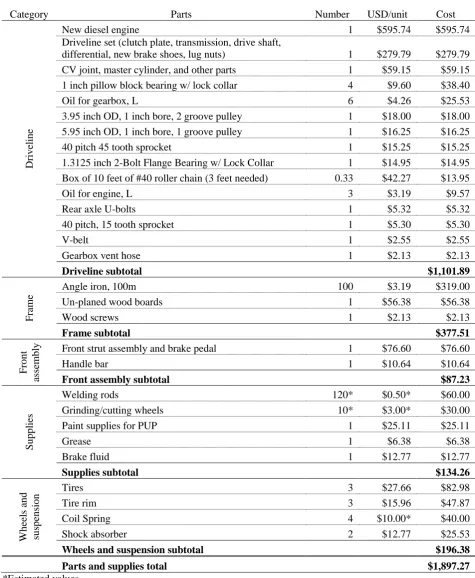148 May, 2015 Manufacturing agricultural utility vehicles in sub-Saharan Africa Special issue 2015
Manufacturing agricultural utility vehicles in sub-Saharan
Africa
David D. Wilson and John H. Lumkes
*(Purdue University, Department of Agricultural and Biological Engineering, 225 South University Street, West Lafayette, IN 47907-2093)
Abstract: Reliable and affordable transportation is vital to economic growth. Transportation connects products to markets, people to education, and supplies to businesses and farms. However, Sub-Saharan Africa (SSA) generally has poor road infrastructure. Cameroon, a country of 23 million people in Central Africa, is no exception with paved roads comprising only 8% of all roads. Many of the unpaved roads are not maintained and are in poor condition. In addition, access to motorized transportation is severely limited in Cameroon where there are only 19 motorized vehicles per 1000 people and all of these vehicles are imported. Little work has been done on developing a vehicle that is affordable, locally manufactured, and suitable to the roads in SSA.
A university/NGO partnership has been working on affordable transportation and agricultural mechanization through the development of the Practical Utility Platform (PUP). The PUP is a three-wheel multipurpose vehicle with a carrying capacity of 900 kg. While primarily a transportation vehicle, the PUP can be used for many other operations requiring power. Water pumps, generators, grinders, and similar devices are easily powered off of the engine, making the PUP a portable power source. Also, testing has been performed where the vehicle successfully pulled ground-engaging agricultural implements. These added capabilities make the PUP more valuable to end-users.
The PUP can be built using parts and materials that can be obtained in Cameroon. The vehicle frame uses a single, common size of angle iron that is locally available. To power the vehicle, any 5-9 kW engine can be used. A belt and pulley set and a chain and sprocket set provide the necessary reduction for a maximum vehicle speed of about 35 km/hr. The driveline uses the transmission, driveshaft, and rear axle from a small car or truck, as there are many salvaged car parts locally available. The front strut, wheels, and brake system also recycled. Various prototypes have been designed, built, and tested extensively, both at the university and in Cameroon. The vision of this partnership is to set up a micro-factory for manufacturing these vehicles independently. Local manufacturing provides employment opportunities and boosts the local economy. Similar manufacturing models can be implemented in many other places in SSA, extending the impact. The PUP is designed for simplicity in manufacturing. The only necessary power tools are a drill, a grinder, and a welder. The frame is designed to utilize simple cuts and welds. The total cost of parts and materials for one PUP is typically under $2000 USD. With the low cost of labor, and an estimated build time of three weeks per vehicle, a PUP can be built and sold with a profit for a very reasonable price. In summary, an affordable vehicle has been designed that meets multiple transportation and utility requirements, and can be built in Cameroon using locally available resources.
Keywords:utility vehicles, sub-Saharan Africa, local manufacturing, agricultural vehicles, Cameroon
Citation: David, D. W., and J. H. Lumkes. 2015. Manufacturing agricultural utility vehicles in sub-saharan Africa. Agric Eng Int: CIGR Journal, Special issue 2015: 18th World Congress of CIGR: 148-159.
1 Introduction
1Quality and affordable transportation is critical to a
stable food chain. When smallholder farmers have
Received date:2014-10-16 Accepted date: 2014-11-03 *Corresponding author: John H. Lumkes, Purdue University, Department of Agricultural and Biological Engineering, 225 South University Street, West Lafayette, IN 47907-2093. Email: lumkes@purdue.edu.
access to affordable transportation, their cost and time in
transporting agricultural products is reduced and they
have better access to agricultural inputs and markets.
"Transportation needs to be seen as a key element in the
value chain. Transportation costs can be a large
proportion of total marketing costs" (Conway, 2012).
The Sub-Saharan Africa Transport Policy Program
Africa that, “improved rural transport is a prerequisite for poverty alleviation” (Starkey, 2007).
According to the CIA World Factbook, 92% of
roadways in Cameroon are unpaved (The CIA World
Factbook n.d.). Unpaved roads in rural areas are often
in very poor condition, making travel even more difficult
(Figure 1). In Cameroon, there are only 19 motor
vehicles per 1,000 people (World Bank n.d.). A World
Bank report states that, “For smallholders, the movement
of grain from field to farm store is often still by head load
or bicycle and, in some places, by animal-drawn carts”
(The World Bank 2011). Currently, most transport is on
foot, which takes significantly more time and energy
when compared to motorized transportation, especially
when transporting a load. Many motorbikes can be
found in the cities and rural areas of Cameroon.
Although fairly inexpensive, these are appropriate for
transporting a few people or a small load. Imported
trikes can carry a larger load, but are best suited to the
city and won’t handle the poor road conditions found in
many rural areas. Old, imported cars travel rural roads,
but they are much more expensive and were designed to
carry people, not cargo. Small trucks can carry larger
payloads, but are even more expensive and complex,
making maintenance difficult.
Figure 1 One of many roads in poor condition in rural
Cameroon
The SSATP report states that, “In all the areas
surveyed, rural women and men complained that
inadequate transport prevented them from increasing their
productivity and improving their livelihoods. They said
it was pointless to grow or make things for sale if there
was no access to a suitable market. Because of poor
transport, many rural people remain primarily subsistence farmers, with little impact on the regional economy”
(Starkey, 2007). Poor or limited transportation can also
cause post-harvest losses, because of delays from slow
transportation. A study in Nigeria showed post-harvest
losses ranging from 20 to 40 percent (F.F. Olayemi,
2012). In Tanzania, up to 13% of those losses are
directly caused by transportation (World Bank, 2009).
The results of a 2008 study done in East Africa showed
that transportation costs are around 76% of the total
maize marketing costs (The World Bank, 2011).
Sub-Saharan Africa is generally lagging behind
agricultural production, even in comparison to other
developing regions (FAO and UNIDO, 2008).
Providing power in agriculture is critical for moving
smallholder farmers out of subsistence farming and
growing the local and national economies. Low
production is, in part, due to a general lack of agricultural
mechanization across the continent. With a density of
1.1 tractors per 1000ha, the mechanical energy utilized in
agriculture is weak and shrinking (FAO, 2010).
Although mechanizing agriculture by importing
tractors may work in the short-term and on large farm
operations, this method is neither sustainable nor viable
for small-holder farmers. With no in-country parts
distributers, it takes just one broken part to put the whole
machine out of service. Even if the owner or operator
can order a part, the time delay makes the machine
useless for field and processing operations that season.
Additionally, there is likely to be little or no local
expertise on maintaining and repairing foreign-made
agricultural equipment. This is true for transportation
vehicles, as well. A motor vehicle is expensive to
import and the supply of parts is limited, although this is
improving with some manufacturers, particularly Chinese
motorbike companies. If importing machines, equipment,
or vehicles is to be successful, it must be coupled with
150 May, 2015 Manufacturing agricultural utility vehicles in sub-Saharan Africa Special issue 2015
Importing is not the only option. Local
manufacturing has many advantages. First, the cost to
the customer for the equipment or vehicle decreases
greatly, as shipping costs and import duties are removed.
Another advantage is the development of the products is
within close proximity to the customers of the products.
This helps in making tools and machines that are suitable
for the work required of them. Designs can be made
that accommodate the local agricultural practices, climate,
and specific demands. The close proximity allows for
better feedback for better products. “Local manufacture
has the advantage of being able to respond directly and
rapidly to the demands of the agricultural sector” (Sims et
al., 2012). Another advantage of locally manufacturing
equipment is that it boosts the economy. Not only do
farmers benefit, but they will pass the benefits on to the
consumers of their products and the manufacturing
industry will also help build the local economy.
2 Design
The Practical Utility Platform (PUP) (Figure 2) is a
vehicle designed to be an affordable and locally
sustainable intermediate means of transport (IMT) for
goods and materials in rural Sub-Saharan Africa (SSA)
and also a platform for powering other machines. The
three-wheel vehicle can be built completely out of parts
and materials available in Cameroon. Most of the main
driveline and suspension parts are recycled from old cars.
The PUP is designed with flexibility as to the type of cars
and light trucks from which the parts are taken. In
Cameroon, parts from 1980’s RWD Toyota Corollas are
used since these cars have been common and the recycled
components required for the PUP (coil springs, rear axle,
and transmission) still function well when the vehicles are
scrapped. In addition to field tests of the PUP, several
agricultural attachments and implements for the PUP
have also been designed and tested (Wilson and Lumkes,
2014).
Figure 2 CAD model of the practical utility platform
(PUP)
The overall length of the vehicle is 3.6 m and the
height is 1.7 m (
Figure 3). The bed is 1 m wide and almost 2 m long,
giving a total cargo area of 1.9 m2. The wheelbase is
about 2.5 m. Because of the flexibility of the design (e.g.
the use of parts from a variety of cars), some of these
dimensions can vary from vehicle to vehicle. The track
width depends on the rims and rear axle that are used.
The frame of the PUP uses about 100 m of 30x30x3 mm
angle iron, a very common size of angle iron. Because
of the efficiency of the truss design, minimal material is
required to make the frame, allowing it to be lightweight,
yet very strong. The bed, seats, and floor board, can be
made of a variety of wood boards.
The PUP is designed to use a small diesel or gasoline
engine (Figure 4A), around 5-8kW. The vehicles built
in Cameroon have so far used single cylinder, 6.8 kW
(9.1 hp) diesel engines, however, the make and model do
not matter, allowing each manufacturer to utilize locally
available options. From the engine under the passenger
seat, a pulley and belt reduction (Figure 4B) of 1.5:1 (low)
or 2.25:1 (high) transmits power to a jackshaft (Figure
4C). The clutch is an idler pulley tensioning and
de-tensioning the belt. There is a 3:1 sprocket and chain
reduction (Figure 4D) from the jackshaft to the
transmission gearbox. This is very close to the 15 to 42
tooth reduction common on motorbikes, which can be
found throughout SSA. The transmission gear box
(Figure 4E) is a manual transmission from a RWD car or
from which the transmission is taken, it provides four to
five forward speeds and one reverse speed. A drive
shaft (Figure 4F) transmits the power from the output of
the transmission to the input of the differential rear axle
(Figure 4G), which provides the final reduction of the
driveline.
Figure 3 Dimensions of the PUP
152 May, 2015 Manufacturing agricultural utility vehicles in sub-Saharan Africa Special issue 2015
The rear suspension consists of two shocks and,
depending on the stiffness required, two or four coil
springs between the trailing arm and the bed. The rear
axle is rigidly attached to a trailing arm frame that is
hinged on the frame below the front of the bed. The
trailing arm integrates a torsion bar to provide excellent
roll-stiffness relative to typical three-wheel vehicles.
The torsion bar is made by welding four pieces of angle
iron into the shape of a square. The front wheel uses a
full strut, left or right, from the front of a car. As in a
car, it is attached to the frame so as to allow freedom of
motion to steer. A simple handle bar and extension is
attached for steering. The braking system uses a master
cylinder from a car, the original brakes on each of the
three wheels, and regular brake lines. The clutch and
brake are activated with pedals as in a car and the engine
throttle cable can also be attached to an accelerator pedal
or a squeeze lever on the handle bar. Other small
components of the PUP can be made or found locally.
3 Manufacturing
The PUP is designed to be manufactured using only
local skills and tools. The primary processes in
manufacturing the PUP are cutting angle iron, welding,
grinding, and drilling. The ACREST workshop has the
equipment required for each of these tasks. For four
years, teams of students from Purdue have spent three to
four weeks in Cameroon, and each year they have built a
PUP while working alongside ACREST employees.
This has provided invaluable feedback for designing the
PUP for manufacturability. Usually a PUP can be
driven within three weeks of the start of the build process.
These three weeks consist of 7 to 8 hour days, five days a
week, and the help of 6 to 8 students, one professor, one
welder, and one mechanic or technician. However,
there are often power outages and missing parts, which
delay progress during the three weeks. Also, during that
time, some people may be gone for a day getting parts or
be working on repairing another vehicle. If there is
power, the main frame assembly can take just a few days.
The slowest parts of manufacturing are positioning and
attaching the front strut and the driveline.
Since there are about 200 separate pieces of angle iron
used in the PUP, cutting angle iron is one of the most
repeated tasks in building a PUP. Cutting can be done
by hand with a hacksaw, with a cutting wheel on a
grinder, with a band saw, or with an angle iron shear. A
hacksaw is inexpensive, but time and energy consuming.
Although the hacksaw blades do not last long, they are
inexpensive and easy to replace. When using a hacksaw,
it can be difficult to make exact or straight cuts, although
that is unnecessary for most parts. Using a grinder with
a cutting wheel is much quicker than a hacksaw, but can
also be difficult to control for precise and straight cuts.
While more expensive than hacksaws, grinders are not
very expensive, although they require electricity to run.
Grinder blades also wear down and area slightly more
expensive compared with hacksaw blades. Bandsaws
are easy to use, make straight and exact cuts, but are
expensive, slow, and require electricity. Although
bandsaw blades last a long time, they are even more
expensive and difficult to replace relative to grinder and
hacksaw blades. An angle iron shear is very fast and
can be precise. The cuts are very straight, but the angle
iron can twist slightly at the ends. A shear is somewhat
expensive as are the replacement blades, although they do
not need to be replaced often. A shear does not require
electricity to operate, but, unlike the other options, it can
only make 90° cuts. Hacksaws and grinders are
available in Cameroon and were used to fabricate the
PUPs until the trip in 2014 when an angle iron shear was
brought to ACREST to make the task easier. A band
saw would be difficult to obtain and maintain.
The ACREST machine shop has a shielded metal arc
welder, also known as a stick welder, which is widely
used in Cameroon as it is a fairly simple welder. When
the voltage and current are correctly set, stick welding is
sufficient for the whole vehicle. However, care must be
taken to make good penetration for solid welds, as some
stresses. If a PUP has good welds, it should not fail
under normal loading conditions, but it is subjected to
over-loading and does fail, it can be easily fixed with
welding, and sometimes the addition of reinforcing
members.
The assembly manual contains instructions for the
frame assembly, suspension assembly, transmission and
jackshaft assembly, clutching and engine assembly, and
woodworking. The assembly manual also includes a
parts list, a tool list, and fabrication tips and tricks. To
reach a broader audience, many photographs, models, and
drawings are used, minimizing the dependency on written
words for comprehension. Example pages from the
assembly manual are in the Appendix,
Figure 5 through
Figure 8.
4 Cost
There is no stock price for a PUP, as each vehicle
built so far has been a prototype, but the following is a
description of the expenses occurred or approximated for
the PUP built in Cameroon in May of 2014. A summary
of the cost for the PUP is in Table 1. A more complete
listing is provided in the Appendix in Table 2 (page 149).
Table 1 Cost list summary for 2014 PUP built in
Cameroon
Parts Cost
Percentage of total Driveline subtotal $ 1,101.89 58%
Frame subtotal $377.51 20%
Front assembly subtotal $87.23 5%
Supplies subtotal $134.26 7%
Wheels and suspension subtotal $196.38 10% Parts and supplies total $ 1,897.27 100%
The driveline is clearly the most expensive
subassembly of the PUP, claiming 58% of the total
estimated costs. The most expensive part in the
driveline, and in the whole PUP, is the engine. For this
prototype, a new Chinese, single cylinder, diesel engine
was purchased in Cameroon for 596 USD, 31% of the
total PUP cost. Smaller engines (4.8 kW; 6.5 hp) can be
found for about 350 USD (diesel) or 170 USD (gasoline).
The other major cost in the driveline is the car parts:
clutch plate, transmission, drive shaft, and differential.
These cost 280 USD (15% of the total) for the 2014
prototype in Cameroon (included new brake shoes and
lug nuts). The only other single large cost of the PUP is
the 100 m of angle iron for the frame, which cost 319
USD (17% of the total). Together, these three account
for 63% of the vehicle cost.
It is expected that if multiple vehicles were to be
manufactured, then parts could be purchased in a larger
quantity and unit prices would decrease. For example, if
ACREST plans to build 20 PUPs, they could order a crate
of engines through a supplier or directly from the engine
manufacturer. This would decrease or eliminate
middleman, stock, and display costs from the price. The
same is true for most of the other parts, even if locally
supplied. Also, many of the parts were purchased in
Cameroon by the Purdue team. Since few items have
listed prices there, retailers sometimes mark up the prices
for the foreigners, while a local would get a lower price.
In addition, there was usually a shortage of time for
acquiring parts, so it wasn’t always possible to find the
lowest prices. If these factors could be eliminated, then
the parts and supplies total for one vehicle could be
reduced to less than 1500 USD.
5 Conclusion and future work
Similar versions of the PUP described here have been
built in Cameroon in 2012, 2013, and 2014. During the
2014 visit to Cameroon the 2012 and 2013 vehicles were
still useable, although both required maintenance,
primarily with the engine and driveline components, and
one had been set aside for a lack of good tires.
Additionally, a change in the 2013 trailing arm design led
to crack propagation along the welds, and ultimately
failure. This was rebuilt and updated to the 2014 design.
154 May, 2015 Manufacturing agricultural utility vehicles in sub-Saharan Africa Special issue 2015
experienced significant hours of use and valuable
feedback has been collected. The design continues to
evolve in pursuit of lower operating costs, manufacturing
costs, and features. Each year, alternative clutching
mechanisms, engine and drivelines configurations, and
manufacturing methods are considered by students on
capstone design teams. The basic platform has performed
very well, with the angle iron truss frame providing a
light-weight and durable platform, and recycled
automotive components providing a durable and
economical driveline. Local belts, used for the clutch,
have suffered premature failures. These belts are locally
available and low cost, but it is inconvenient in terms of
maintenance. Alternative clutching mechanisms are being
considered.
The PUPs are heavily relied on by ACREST to haul
water, people, construction equipment, and transporting
goods to and from the markets. Significant progress has
been made on the development of a reliable, low-cost,
and locally manufactured and sustainable multipurpose
utility vehicle.
6 Acknowledgements
The authors are thankful to ACREST for a productive
partnership and to the many undergraduate students who
have been a critical factor in the development of PUP.
This project would not have been possible without the
support of the John Deere Foundation, Global Center for
Food Systems Innovation (GCFSI)/USAID, the ASABE
Giving Back Fund, and Purdue University through the
Global Engineering Program, Vice Provost Office for
Engagement, and the Department of Agricultural and
Biological Engineering.
References
Conway, Gordon. 2012. One Billion Hungry: Can We Feed the World? Cornell University Press.
Olayemi, F. F., Adegbola, J. A., Bamishaiy,e E. I., and Awagu, E. F. 2012. Assessment of post harvest losses of some selected crops in eight local government areas of rivers state, Nigeria. Asian Journal of Rural Development.
FAO and UNIDO. 2008. Agricultural mechanization in Africa: Time for action. Vienna, Austria: FAO.
FAO. Summary of world food and agricultural statistics. 2010. Rome: Food and Agriculture Organization of the United Nations.
Sims, Brian G., Bhatti, Akhtar M., Mkomwa, Saidi, and Kienzle, Josef. 2012. Development of mechanization options for smallholder farmers: examples of local manufacturing opportunities for sub-Saharan Africa. Paper presented at The International Conference of Agricultural Engineering. Valencia, Spain: CIGR-AgEng2012.
Starkey, Paul. 2007. Rural transport services in Africa. Working Paper, Sub-Saharan Africa Transport Policy Program (SSATP),.
The CIA World Factbook. 2014. n.d. https://www.cia.gov/library/publications/the-world-factbook/ (accessed June 27, 2014).
The World Bank. 2011. MISSING FOOD: The Case of Postharvest Grain Losses in Sub-Saharan Africa. Technical Report, Washington D.C.: The World Bank; NRI; FAO. Wilson, David W. and Lumkes, John H. 2014. Agricultural
applications of the practical utility platform for developing countries. Beijing: CIGR.
World Bank. 2014. n.d. http://data.worldbank.org/indicator/IS.VEH.NVEH.P3 (accessed June 27, 2014).
Appendix
156 May, 2015 Manufacturing agricultural utility vehicles in sub-Saharan Africa Special issue 2015
158 May, 2015 Manufacturing agricultural utility vehicles in sub-Saharan Africa Special issue 2015
Table 2 Cost list for 2014 PUP built in Cameroon
Category Parts Number USD/unit Cost
D
ri
vel
ine
New diesel engine 1 $595.74 $595.74
Driveline set (clutch plate, transmission, drive shaft,
differential, new brake shoes, lug nuts) 1 $279.79 $279.79
CV joint, master cylinder, and other parts 1 $59.15 $59.15
1 inch pillow block bearing w/ lock collar 4 $9.60 $38.40
Oil for gearbox, L 6 $4.26 $25.53
3.95 inch OD, 1 inch bore, 2 groove pulley 1 $18.00 $18.00
5.95 inch OD, 1 inch bore, 1 groove pulley 1 $16.25 $16.25
40 pitch 45 tooth sprocket 1 $15.25 $15.25
1.3125 inch 2-Bolt Flange Bearing w/ Lock Collar 1 $14.95 $14.95
Box of 10 feet of #40 roller chain (3 feet needed) 0.33 $42.27 $13.95
Oil for engine, L 3 $3.19 $9.57
Rear axle U-bolts 1 $5.32 $5.32
40 pitch, 15 tooth sprocket 1 $5.30 $5.30
V-belt 1 $2.55 $2.55
Gearbox vent hose 1 $2.13 $2.13
Driveline subtotal $1,101.89
Fra
m
e Angle iron, 100m 100 $3.19 $319.00
Un-planed wood boards 1 $56.38 $56.38
Wood screws 1 $2.13 $2.13
Frame subtotal $377.51
Front
as
se
m
bl
y Front strut assembly and brake pedal 1 $76.60 $76.60
Handle bar 1 $10.64 $10.64
Front assembly subtotal $87.23
Suppl
ies
Welding rods 120* $0.50* $60.00
Grinding/cutting wheels 10* $3.00* $30.00
Paint supplies for PUP 1 $25.11 $25.11
Grease 1 $6.38 $6.38
Brake fluid 1 $12.77 $12.77
Supplies subtotal $134.26
Wheel
s a
nd
sus
pens
ion
Tires 3 $27.66 $82.98
Tire rim 3 $15.96 $47.87
Coil Spring 4 $10.00* $40.00
Shock absorber 2 $12.77 $25.53
Wheels and suspension subtotal $196.38
Parts and supplies total $1,897.27
